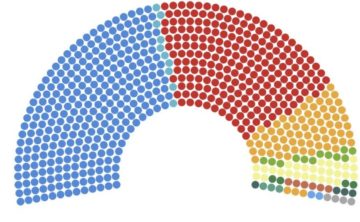by John Allen Paulos
 In politics, business, and education, the issue of how to ensure proportional representation of groups is often salient. A salient issue, but usually an impossible task. Why?
In politics, business, and education, the issue of how to ensure proportional representation of groups is often salient. A salient issue, but usually an impossible task. Why?
Since group identity and wokeness arouse so much emotion, a “geologic upheaval of thought” as Proust characterized it, it’s probably best to discuss a couple of simple illustrative scenarios abstractly. Consider, for example, a well-meaning institution, the Earnest Enterprises Foundation say, operating in a community that contains a numerically dominant majority group, Maj, and two subgroups – a substantial minority group, Min, and a smaller minority group, Sm, which has members in group Maj as well as members in group Min. Let’s assume that the group Maj constitutes 75% of this imaginary community, Min the remaining 25%, and let’s also assume that 10% of the community belongs to group Sm, whose members are known to be somewhat marginalized and less likely to self-identify as Sm, self-identity being a somewhat nebulous notion. This latter assumption introduces complications since the extent to which the groups differ, self-identify, and intersect is unknown to the foundation or even to the community. Let’s further assume that only 4% of group Min members self-identify as Sm and 8% of the group Maj members self-identify as Sm.
Making a well-intended attempt to assemble a workforce of 1,000 which “fairly” reflects the community, the foundation most naturally (but not necessarily) prioritizes the Maj-Min dichotomy and hires 750 members of group Maj and 250 members of group Min. But this is problematic since just 10 members of the group Min (4% of 250) would self-identify as being in group Sm, AND 60 members of the group Maj (8% of 750) would self-identify as being in group Sm. Thus ONLY 70 or 7% of all 1,000 workers would be self-identified members of group Sm.
It follows that, despite their best efforts, Earnest Enterprises would still be liable to charges of bias. It could obviously be accused by its Min employees of being anti-SM since only 4% of the Min employees (10 of 250) would be in group Sm, not the assumed community‑wide 10%. Interestingly, the foundation’s group Sm employees could likewise claim that the foundation was anti-Min since only 14.3% of the self-identified Sm members (10 of 70) would be from group Min, not the community‑wide 25%.
Of course, the foundation could instead decide to fill 10% or even more of its positions with members of the group Sm (especially if it’s a privileged group rather than a marginalized one) and a smaller percentage from non-Sm members of group Maj and group Min. This would likely also lead to an outcome in which people would not be hired in numbers proportional to their percentages in the community and would lead to further objections and resentments. Not to belabor the point, but the percentages assumed above could be changed considerably as could the characteristics of the groups involved and similar potentially contentious outcomes would still result.
We should also factor in other groups – groups P, Q, R – whose memberships would intersect to various unknown degrees, and whose members would likely have dissimilar backgrounds. The Maj-Min-Sm scenario above is, of course, just one of many that are possible that could lead to resentful groups and serious conflict. In addition, group definitions and memberships change over time. There are Democans (Democrats before Reagan and Republicans after) and Republicrats, transwomen and transmen, and, more theoretically, Nelson Goodman’s grue emeralds and bleen skies.
Yet another way in which an organization’s good intentions can conduce to significant disparities between groups depends on an uncritical scientistic use of the normal statistical distribution. Consider two population groups, X and Y, that differ in backgrounds and thus along some dimension, say something objective, unchanging, and uncontentious, like height. Even if the average height of group X members is only slightly greater than the average height of group Y members, members of group X will make up a significant majority of those who are very tall and members of group Y will make up a significant majority of those who are very short, this despite the fact that that a big majority of each group’s members are of roughly average height. Shifting the bell-shaped graph a little bit to the left or right will always have a great effect on the tails of the bell-shaped distribution (assuming comparable variances).
What should the Earnest Enterprises Foundation and the community in general do? It probably wouldn’t be hard to devise an app in which different groups’ percentages, overlaps, and backgrounds could be manipulated and played with and the resulting outcomes evaluated to find those that are the least “unfair.”
The scare quotes are there because issues involving proportional representation lie way beyond simplistic arithmetic and the tendentious assumptions that are often made about it. In many situations it’s inappropriate, even indefensible to strive for such equal results. Doing so clearly can be antithetical to personal freedom and to group well-being.
In any case the bottom line is that statistical deviations from proportionality will almost certainly result whatever measures are taken. Sadly, virulent biases and resentments are all too real and pervasive without making them our unthinking first inference when confronted with such deviations. Sometimes it’s just math.
***
John Allen Paulos is a Professor of Mathematics at Temple University and the author of A Mathematician Reads the Newspaper, Innumeracy, and a forthcoming book, tentatively titled Who’s Counting – Puzzles, Probability, and Politics with a Smidgeon of Whimsy.
